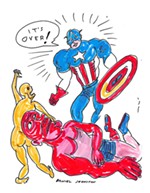Never Say Die!
Austin's arts scene plays 'the comeback kid' in 2004
By Robert Faires, Fri., Jan. 7, 2005
Still, the curtain hadn't fallen on this drama, and 2004 saw the third act open with the cultural community picking itself up off the mat. All through the year, arts organizations kept fighting their way back toward that dream of a new city, culturally revamped, envisioned in the late Nineties. The Long Center, forced to scale back its grand vision of a four-theatre performing-arts complex into one with two venues, unveiled a new design from local heroes TeamHaas and renewed its push to build it. By year's end, the center still hadn't broken ground, but it had raised almost $10 million in its comeback charge and had new blood – director Cliff Redd, hired in July – at the helm. UT's Blanton Museum of Art, meanwhile, saw its new facility steadily taking shape at Speedway and MLK and moved within $12 million of the $87 million needed to complete the project. Over on Congress, another visual-arts institution, the statewide association Arthouse, announced a major step in its growth: establishment of the Texas Prize, a new biennial award for an artist living or working in the Lone Star State that comes with a cash prize of $30,000. The city's arts-funding process, which all but imploded in recent years, received an initial overhaul, led by new Cultural Arts Program Manager Vincent Kitch. For the first summer in ages, the cries of unfairness and conflict of interest accompanying the annual process were muted. In the end, the effectiveness of the reforms was muddied by the new funding formula's application to the still badly depleted pot of bed tax money, which left many arts groups facing funding cuts upward of 45% and prompted City Council to intervene with an alternative funding scheme. But Kitch is back at the drawing board, working with local artists and administrators to refine the reforms. Then there was Tapestry Dance Company, which faced a financial crisis nearly as life-threatening to its season as the health crisis to Artistic Director Acia Gray the year before. Showing a fierce resolve to survive, the troupe raised $30,000 in just over two weeks, and the show did go on.
Granted there were undeniable losses during 2004 – the most heartbreaking of which was easily the murder of UT piano professor Danielle Martin by a student and friend with mental problems – but in large measure the spirit of the year was "never say die," with the Austin arts scene in the role of comeback kid. Whether the drama of "the kid" will end in triumph or tragedy is still in question and may take a few more years to play out. But you can be sure that whatever happens, he'll keep swinging, and the artists and companies of this city will continue to produce memorable creative works. The lists in the following pages are testament to that.








